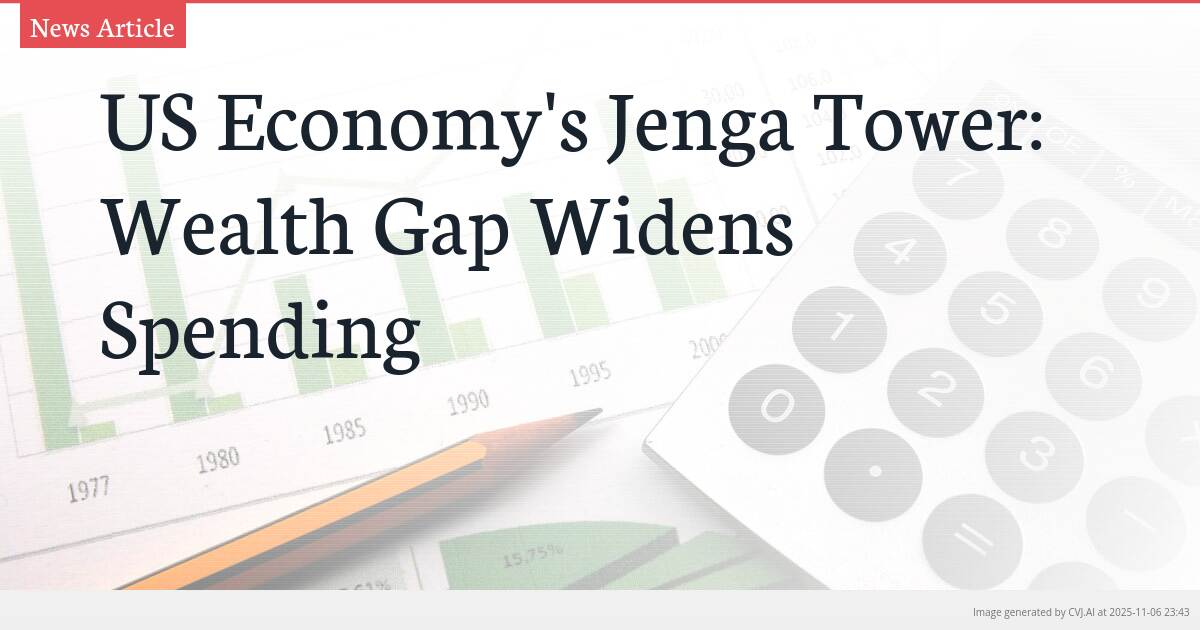This summary text is fully AI-generated and may therefore contain errors or be incomplete.
Introduction
The apparent resilience of the US economy is being propped up by high-income households while lower and middle-class families face increasing financial strain. The wealthiest 10% now account for nearly half of all consumer spending, creating a dangerous economic divergence. This growing imbalance raises concerns about the sustainability of current economic growth patterns and the potential for a more pronounced economic slowdown.
Key Points
- Top 10% of households account for nearly 50% of total US consumer spending
- Lower-income families are reducing spending due to persistent high living costs and budget constraints
- Economists warn this divergence creates a 'jenga tower' effect making the economy vulnerable to sudden slowdown
The Spending Divide Deepens
The US economy is experiencing a fundamental split in consumer behavior that threatens its underlying stability. According to recent analysis, the richest 10% of households are now fueling nearly half of total US spending, creating an unprecedented concentration of economic power among the wealthiest Americans. This trend represents a significant departure from historical spending patterns where consumption was more evenly distributed across income brackets.
Meanwhile, lower-income families are being forced to pull back on spending in the face of persistently high living costs and tightening budget constraints. The divergence between these two groups has created what Bloomberg’s Catarina Saraiva described as a ‘jenga tower’ economy during her appearance on ‘Bloomberg Businessweek Daily’ with Norah Mulinda and Bailey Lipschultz. The analogy perfectly captures the precarious nature of an economic structure that appears stable on the surface but grows increasingly vulnerable as its foundation weakens.
The Foundation Cracks
The strain on lower and middle-income households represents a critical vulnerability in the US economic framework. While high-income consumers continue to drive economic activity through robust spending, families further down the income ladder are facing mounting financial pressure. This economic bifurcation means that nearly 50% of consumer spending—traditionally the engine of US economic growth—now depends on a relatively small segment of the population.
The concentration of spending power creates multiple points of fragility. Should high-income households reduce their consumption for any reason—whether due to market volatility, changing consumer confidence, or external economic shocks—the entire economic structure could experience rapid destabilization. The current situation mirrors the unstable nature of a Jenga tower, where removing key supporting blocks can trigger sudden collapse despite the structure’s apparent stability.
This dynamic is particularly concerning given that consumer spending accounts for approximately two-thirds of US economic activity. The heavy reliance on wealthy households creates an economic model that lacks the broad-based support necessary for sustainable long-term growth.
Warning Signs for Economic Stability
Economists and financial analysts are growing increasingly concerned about the implications of this spending divergence. The Bloomberg analysis highlights how the US economy is becoming susceptible to a more pronounced slowdown as the wealth gap continues to dictate consumption patterns. The current situation represents a significant departure from traditional economic models where middle-class spending provided stable, predictable economic momentum.
The ‘jenga tower’ analogy used by Catarina Saraiva during the Bloomberg discussion underscores the fragility of an economy overly dependent on high-income consumption. As lower-income families continue to pull back spending due to budget constraints, the economic foundation becomes increasingly narrow and unstable. This creates conditions where even minor economic disruptions could trigger disproportionate consequences.
The warning from Bloomberg analysts suggests that policymakers and market participants should view current economic strength with caution. While surface-level indicators may show resilience, the underlying structure reveals significant vulnerabilities that could manifest in sudden economic contractions or prolonged slowdowns if current trends continue unchecked.
📎 Read the original article on bloomberg.com

